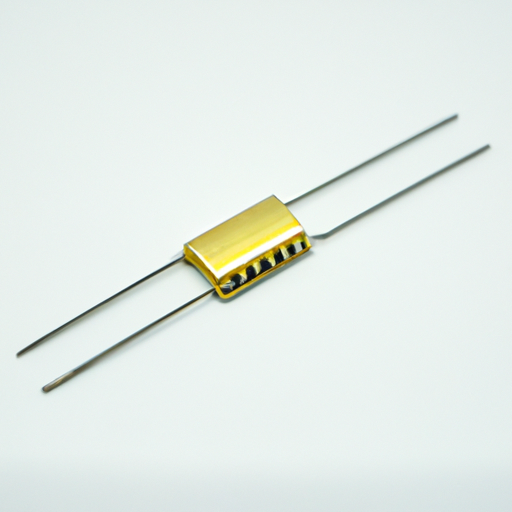Title: A Comprehensive Guide to Popular Transistor Product Types

1. Bipolar Junction Transistors (BJTs) (200 words) Bipolar Junction Transistors (BJTs) are one of the most commonly used transistor types. They consist of three layers of semiconductor material, namely the emitter, base, and collector. BJTs are further classified into two main categories: NPN (Negative-Positive-Negative) and PNP (Positive-Negative-Positive). These transistors are known for their high current gain and low output impedance, making them ideal for applications requiring amplification, such as audio systems and power supplies.
2. Field-Effect Transistors (FETs) (250 words) Field-Effect Transistors (FETs) are another widely used transistor type. Unlike BJTs, FETs are voltage-controlled devices that rely on an electric field to control the flow of current. FETs are further divided into two subcategories: Junction Field-Effect Transistors (JFETs) and Metal-Oxide-Semiconductor Field-Effect Transistors (MOSFETs).
2.1 Junction Field-Effect Transistors (JFETs) JFETs are constructed using a single semiconductor material and are available in two types: N-channel and P-channel. These transistors are known for their high input impedance, low noise, and excellent linearity. JFETs find applications in amplifiers, mixers, and low-noise preamplifiers.
2.2 Metal-Oxide-Semiconductor Field-Effect Transistors (MOSFETs) MOSFETs are the most widely used FETs due to their versatility and high input impedance. They are further classified into two types: N-channel and P-channel. MOSFETs offer low power consumption, high switching speeds, and excellent noise performance. They are commonly used in digital circuits, power supplies, and switching applications.
3. Darlington Transistors (150 words) Darlington transistors are a special type of BJT configuration that provides high current gain. They consist of two BJTs connected in a way that amplifies the current gain of the overall circuit. Darlington transistors are commonly used in applications requiring high current amplification, such as motor control, robotics, and audio amplifiers.
4. Insulated-Gate Bipolar Transistors (IGBTs) (200 words) Insulated-Gate Bipolar Transistors (IGBTs) combine the characteristics of both MOSFETs and BJTs. They are designed to handle high voltage and high current levels, making them suitable for power electronics applications. IGBTs are commonly used in motor drives, power supplies, and renewable energy systems.
5. Thyristors (200 words) Thyristors are a family of semiconductor devices that include silicon-controlled rectifiers (SCRs), triacs, and diacs. These devices are used for switching and controlling high-power AC and DC circuits. Thyristors are commonly found in applications such as motor control, lighting control, and power regulation.
Conclusion (100 words) Transistors are essential components in modern electronics, enabling the amplification and switching of electrical signals. This article has provided an overview of popular transistor product types, including Bipolar Junction Transistors (BJTs), Field-Effect Transistors (FETs), Darlington transistors, Insulated-Gate Bipolar Transistors (IGBTs), and Thyristors. Each transistor type offers unique characteristics and applications, allowing engineers and hobbyists to select the most suitable transistor for their specific needs. By understanding the different transistor types and their functionalities, individuals can make informed decisions when designing electronic circuits or troubleshooting existing systems.
Title: A Comprehensive Guide to Popular Transistor Product Types

1. Bipolar Junction Transistors (BJTs) (200 words) Bipolar Junction Transistors (BJTs) are one of the most commonly used transistor types. They consist of three layers of semiconductor material, namely the emitter, base, and collector. BJTs are further classified into two main categories: NPN (Negative-Positive-Negative) and PNP (Positive-Negative-Positive). These transistors are known for their high current gain and low output impedance, making them ideal for applications requiring amplification, such as audio systems and power supplies.
2. Field-Effect Transistors (FETs) (250 words) Field-Effect Transistors (FETs) are another widely used transistor type. Unlike BJTs, FETs are voltage-controlled devices that rely on an electric field to control the flow of current. FETs are further divided into two subcategories: Junction Field-Effect Transistors (JFETs) and Metal-Oxide-Semiconductor Field-Effect Transistors (MOSFETs).
2.1 Junction Field-Effect Transistors (JFETs) JFETs are constructed using a single semiconductor material and are available in two types: N-channel and P-channel. These transistors are known for their high input impedance, low noise, and excellent linearity. JFETs find applications in amplifiers, mixers, and low-noise preamplifiers.
2.2 Metal-Oxide-Semiconductor Field-Effect Transistors (MOSFETs) MOSFETs are the most widely used FETs due to their versatility and high input impedance. They are further classified into two types: N-channel and P-channel. MOSFETs offer low power consumption, high switching speeds, and excellent noise performance. They are commonly used in digital circuits, power supplies, and switching applications.
3. Darlington Transistors (150 words) Darlington transistors are a special type of BJT configuration that provides high current gain. They consist of two BJTs connected in a way that amplifies the current gain of the overall circuit. Darlington transistors are commonly used in applications requiring high current amplification, such as motor control, robotics, and audio amplifiers.
4. Insulated-Gate Bipolar Transistors (IGBTs) (200 words) Insulated-Gate Bipolar Transistors (IGBTs) combine the characteristics of both MOSFETs and BJTs. They are designed to handle high voltage and high current levels, making them suitable for power electronics applications. IGBTs are commonly used in motor drives, power supplies, and renewable energy systems.
5. Thyristors (200 words) Thyristors are a family of semiconductor devices that include silicon-controlled rectifiers (SCRs), triacs, and diacs. These devices are used for switching and controlling high-power AC and DC circuits. Thyristors are commonly found in applications such as motor control, lighting control, and power regulation.
Conclusion (100 words) Transistors are essential components in modern electronics, enabling the amplification and switching of electrical signals. This article has provided an overview of popular transistor product types, including Bipolar Junction Transistors (BJTs), Field-Effect Transistors (FETs), Darlington transistors, Insulated-Gate Bipolar Transistors (IGBTs), and Thyristors. Each transistor type offers unique characteristics and applications, allowing engineers and hobbyists to select the most suitable transistor for their specific needs. By understanding the different transistor types and their functionalities, individuals can make informed decisions when designing electronic circuits or troubleshooting existing systems.